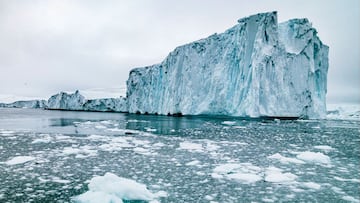Scientific warning of ‘zombie’ virus in the Arctic with high risk of pandemic: ‘The threat is real’
Thawing permafrost, along with increased activity in glaciers, can lead to the spread of viruses that have been frozen for thousands of years.

The change in climate that our planet has been suffering in recent years has caused extreme weather phenomena such as heat waves in the middle of autumn, record temperatures, and heavy snowfalls, among others. It is also causing the permafrost of the main glaciers around the world to melt at a faster rate.
A permafrost is a type of soil or sediment that remains continuously frozen for an extended period of time, and it covers about a fifth of the northern hemisphere. However, it has been reducing in size in the past years.
READ ALSO: The consequences for your body if you do not clean the bottles you reuse
We have something to make your Monday a little brighter - the first #MapMonday of 2024!
— Woodwell Climate Research Center (@WoodwellClimate) January 15, 2024
This striking map from Christina Shintani, using data from Gruber et al 2012, shows current permafrost extent in Alaska.
(🗺️ : @cmshintani ) pic.twitter.com/60UeoI1fUh
Ancient viruses in a state of suspended animation
This terrain has remained at sub-zero temperatures for hundreds of thousands of years, with layers in its deepest areas older than the human species itself. This thaw could be a potential point of contagion for ‘old’ viruses, which remain alive in the permafrost and could re-emerge. The crucial point about permafrost is that it is cold, dark and lacks oxygen, which are perfect conditions for preserving biological material, according to scientists.
After the health emergency caused by the covid-19 virus, scientists believe that a similar situation could occur with these viruses which have been frozen for thousands of years. Scientists have already isolated strains of these Methuselah microbes (also called ‘zombie’), which could lead to an emergency due to a virus emerging from the distant past. For this reason, experts are already working on a surveillance network to identify the first cases, if they do emerge.
““At the moment, analyses of pandemic threats focus on diseases that might emerge in southern regions and then spread north,” geneticist Jean-Michel Claverie of Aix-Marseille University told The Guardian. The expert regrets that “little attention” has been given to a possible outbreak that could arise in the far north.
“There are viruses up there that have the potential to infect humans and start a new disease outbreak,” the scientist warns.
READ ALSO: The US expands coastal territory by one million square kilometers
Trending in #EnvironmentalStudies:https://t.co/mTKMCOgwD7
— OOIR (@ObserveIR) January 23, 2024
1) An increasingly biased view on Arctic change (@NatureClimate)
2) Earth system models must include permafrost carbon processes
3) Supply, demand & polarization challenges facing US climate policies
4) Artificial… pic.twitter.com/aLlhzGWu1g
A change in land use
This fear is shared by virologist Marion Koopmans of the Erasmus Medical Center in Rotterdam.
“There is a real risk that there will be one capable of triggering a disease outbreak, for example an ancient form of polio. We have to assume that something like this could happen.”
Just a decade ago, a team led by Claverie isolated live viruses in Siberia and confirmed that they could infect single-celled organisms, despite having been frozen for thousands of years in permafrost. Those isolated viruses, according to the account, were not a risk to humans. But it does not rule out the possibility that there are others with the capacity to infect humanity.
“We have identified genomic traces of pox viruses and herpes viruses, which are well-known human pathogens.”
The dangers of global warming
Beyond the thaw that could release these viruses, what is also worrying is the consequences that higher temperatures can cause. Melting sea ice would open new avenues in maritime transport and development in places like Siberia, with future operations to extract oil and minerals.
“Those operations will release large quantities of pathogens that still thrive there. The miners will come in and breathe the viruses. The effects could be calamitous,” warns Claverie.
Koopmans recalls that similar changes caused by human behavior have been the architect of the spread of other viruses.
“If you look at the history of epidemic outbreaks, this has been one of the key factors. The Nipah virus was transmitted by fruit bats that were driven from their habitats by humans. Monkeypox has been linked to the expansion of urbanization in Africa,” she points out.
Related stories
That is what could happen in the Arctic, an area with hardly any human activity that could experience a great change with the thawing of the permafrost.
“The scenario that an unknown virus that once infected a Neanderthal would return to us, although unlikely, has become a real possibility,” says Claverie.

